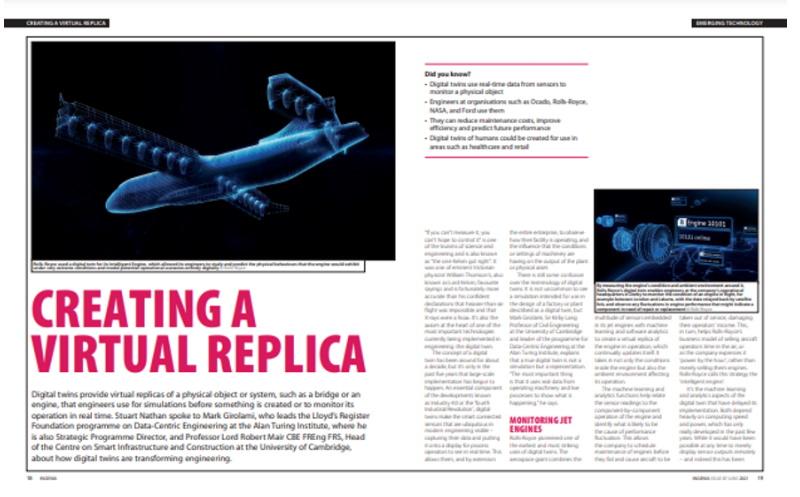
Submitted by L. Millard on Mon, 28/06/2021 - 19:39
An article exploring how digital twins are transforming engineering spotlights a number of pioneering CSIC projects
Charting the emergence and development of digital twins in engineering, the article titled ‘Creating a Virtual Replica’, and published in the June issue of Ingenia, the magazine of the Royal Academy of Engineering, features interviews with Professors Lord Robert Mair, Founding Head of CSIC, and Mark Girolami, Sir Kirby Laing Professor of Civil Engineering and Programme Director at The Alan Turing Institute, as well as Melanie Jans-Singh, a PhD student working with CSIC.
Discussing ways in which digital twins are revolutionising engineering by using reliable and dynamic data capture from smart connected sensors in the built environment to enable operators to monitor and manage assets and facilities more efficiently, Prof Mark Girolami explains a true digital twin as a virtual representation, not a mere simulation: “The most important thing is that it uses real data from operating machinery and live processes to show what is happening.” The concept of digital twins has been around for 10 years, but significant implementations have been carried out in the past few years due to technological advances in machine learning combined with higher computing speed and power.
For a relatively low investment we showed that there was no need to spend millions of pounds Professor Lord Robert Mair, Founding Head of CSIC
The article highlights the pioneering use of digital twins to monitor the performance of jet engines by Rolls-Royce as inspiration for application on civil engineering assets: “We wondered if we could get the same sort of results by implementing that technology on civil engineering assets, particularly railway bridges,” says Prof Lord Robert Mair in the article.
CSIC’s Staffordshire Bridges project, an ongoing collaboration with Network Rail and The Alan Turing Institute, is presented in the article to showcase the possibilities of digital twins in engineering. Two new bridges that form part of the Stafford Area Improvement Programme on the West Coast Main Line were instrumented with fibre optic mixed-sensor monitoring systems to determine their static and dynamic response during whole-life performance. Sensors register how the structures react to the moving forces when trains pass over the bridges and huge amounts of data are produced which are analysed by data scientists at The Turing and relayed to structural engineers at CSIC.
Combining structural and data-driven engineering brings new opportunities to smart infrastructure and the digital twins of the bridges that exist alongside the physical assets are updated via a statistical process as new data are collected. Anomalies in data patterns can alert asset managers to a change or an event in the structure which can be investigated in real time.
Digital twins are not limited to new assets and CSIC researchers have created a digital twin of a Victorian railway viaduct that is part of the main line in Leeds. Asset managers were concerned that the viaduct needed to be replaced, which would be a costly exercise, but by retrofitting the asset with fibre-optic sensors, CSIC researchers were able to create a digital twin and establish that the structure was performing well and would do for many years to come. “For a relatively low investment we showed that there was no need to spend millions of pounds,” says Professor Mair.
The CSIC project Growing Underground has created a digital twin to optimise conditions at an underground urban farm producing micro salad leaves and herbs in former WW2 air raid tunnels located 33 metres below the busy streets of Clapham, London. The farm is working towards producing zero carbon food and the digital twin helps the farm managers better understand the changeable environment and informs operational decision-making to optimise growing conditions while minimising energy use. PhD student Melanie Jans-Singh, who is currently incorporating machine vision into the farm system to enable cameras monitoring the plants to provide additional information on growth levels and colour of the crops, says: “What the digital twin shows is better than being in the tunnel in person. It can monitor, learn, feedback and forecast information that will improve working.”
The article concludes with an exploration of future applications of the technology, going beyond monitoring physical objects and systems to optimising health in human beings.
• Read the full article, ‘Creating a Virtual Replica’, in Issue 87 (June 2021) of Ingenia magazine here
• Subscribe to Ingenia magazine (free) here.
Magazine artwork with permission from Ingenia.
